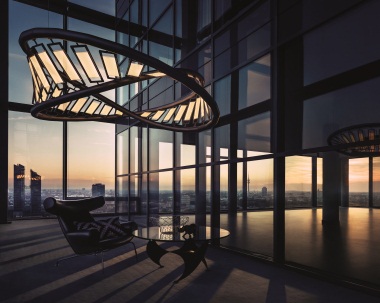
OLEDs from Osram
OLED panels will be on a par with LEDs in terms of performance by next year, according to a market report.
The report by UBI, a South Korean research company, said the OLED lighting market will still be very small in 2015, but will be able to match LED technology in terms of performance. The UBI forecast sees OLED panels reaching 100lm/W and 30,000 lifetime hours by next year.
The report suggested this would encourage quick growth in the OLED lighting market and predicted that will reach $4.7 billion in 2020.
But when Lighting contacted manufacturers to ask whether they agreed with the findings of the report, some felt OLED progress wasn’t quite as rapid. “Market research is a difficult story,” said Karsten Diekmann, head of products, applications and marketing in Oram’s OLED team. “It’s really hard to tell what will be the case in five to 10 years from now.”
“Our key year for performance is 2016, where we anticipate to break the 100lm/W barrier and to be technically competitive with LED technology. We showed a 65lm/W OLED at Lighting + Building this year, which is the same performance of CFL; but sadly nobody is interested in the performance of CFL. Everything is back to LED performance, which is the true benchmark.”
But OLEDs are catching up fast. Diekmann went as far as saying OLEDs are “developing twice as fast” as LEDs. Since 2010, where Oram had OLED performances of 20lm/W and a lifetime of 5,000 hours at L50, huge strides have been made. Today OLEDs are reaching 65lm/W and 15,000 hour lifetimes at L70, with three times as much brightness as before. “Comparing this to LEDs, you have to go back six or seven years to see a doubling of the performance,” Diekmann added.
He also pointed out that LED has a lot more losses than OLEDs do when it comes to thermal and optics. Therefore OLEDs don’t need to be the same efficacy at a component level, to perform as well as LEDs.
“Say you have an OLED component with 100lm/W,” he explained, “and an LED component with 130lm/W, and you built them into a system. Then you have to consider optical means for the LEDs where you have optical losses, and heat sinks for the thermal losses; so the system output it rather comparable. So on a system level, we anticipate OLEDs being comparable in two years.”
Pricing, however, is another matter. Diekmann predicts OLEDs won’t be comparable on price with LEDs until at least 2018 or even 2020 – and this is dependent on market adoption in the preceding years.
“The goal is clear,” he said. “OLEDs have to be competitive in pricing in order to succeed in the lighting market. By having a good technical performance two years from now won’t mean we can start selling OLEDs for the same price. First we need premium projects, new infrastructures, standardisation efforts; then you can start all these economy of scale factors.”
Osram hopes the automotive industry is going to drive the OLED market, and push the costs down for general lighting market adoption. “We think the OEMs in the car industry are desperately looking for possibilities to differentiate themselves from others to create branding by lighting, to have a certain fingerprint from their luminaires.” Diekmann said. “They will be the first adopters of OLED technology. With this we can increase our economies of scale and then move into the general lighting market with OLEDs.”





